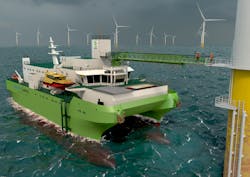Offshore Wind Energy
Wood to modify North Sea platforms for Hywind wind farm
Equinor has contracted Wood to perform modifications to two platforms in the Norwegian North Sea that will receive electric power from floating wind turbines.
Power supplied by the Hywind Tampen development between the Snorre and Gullfaks fields will replace energy currently generated by gas turbines, reducing offshore emissions by more than 200,000 metric tons/yr (220,462 tons).
Under a three-year contract, Wood will provide the topsides modifications at the Snorre A and Gullfaks A platforms to integrate the Hywind floating wind park with existing systems powering the facilities.
The scope of work also includes equipment installation on the floating wind turbines and upgrades to the control room in Bergen that will remotely operate the wind farm.
DEME to build first service operation vessel
In order to increase the range of services it offers the offshore wind industry, DEME says that it is investing in its first service operation vessel (SOV) for offshore wind farm maintenance. Designed in close cooperation with Vuyk Engineering Rotterdam and Marin, DEME says that this vessel will improve safety, comfort and workability for wind farm technicians even in the roughest sea conditions.
The SOV will feature a Small Waterplane Area Twin Hull (SWATH) design, which ensures low wave impact on movements when approaching the wind turbines, compared to a monohull SOV. The vessel will enable safe crew transfers in significant wave heights of up to 2.5 m (8.2 ft), and is said to be the first DP-2, twin-hulled SOV in the world.
With DP-2 capability, the vessel is said to be able to hold its position in rough sea conditions but still operate with lower fuel consumption when compared to traditional SOVs. A reduction of fuel consumption up to 50% can be achieved compared to a monohull SOV.
Due for delivery in 2021, the SOV will be chartered by Siemens Gamesa Renewable Energy as part of a long-term maintenance contract for the Rentel and Mermaid & Seastar (referred as SeaMade) offshore wind farms in Belgium. DEME says that this is the first SOV to serve three different wind farm sites.
Massachusetts selects Mayflower Wind Energy’s project proposal
Mayflower Wind Energy LLC, a joint venture of Shell New Energies US LLC and EDPR Offshore North America LLC, has been chosen by Massachusetts to supply 804 MW of renewable energy from offshore wind to the electricity customers within the state, enough to power approximately half a million homes. This selection is a key step in implementation of the Commonwealth’s nation-leading Section 83C offshore wind development procurement process.
Mayflower Wind anticipates that the project, located more than 20 mi south of Nantucket with expected start-up in 2025, will provide the following economic benefits:
• Long-term prices below the original price cap of $84.23/MWh
• $3.7 billion in electricity rate reduction over the term of the contract
• Creation of up to 10,000 jobs in Massachusetts including both offshore jobs and onshore opportunities
• Elimination of 1.7 million metric tons of CO2 emissions annually from clean energy produced once in operation, the equivalent of taking 350,000 cars off the road.
Saipem wins two construction contracts
Saipem has been awarded a contract by the French company EDF Renewables for the construction of the Neart na Gaoithe (NnG) wind farm offshore Scotland.
This is the first turnkey project awarded to Saipem in the offshore wind farm sector. The scope of work consists of the engineering, procurement, construction, and installation of 54 steel foundation jackets, two steel foundation jackets for the offshore electrical substations and the transportation and installation of the relevant topsides. These jackets will be manufactured partly at a Saipem-owned yard and partly in fabrication facilities in Scotland. The jackets will be placed on piles at depths ranging from 40 to 60 m (131 to 197 ft).
Offshore installation activities will be carried out by the crane vessel Saipem 7000.
The NnG offshore wind farm, 15 km (9.3 mi) off the east coast of Scotland, will be deployed over an area of 105 sq km (40.5 sq mi) and will be capable of generating around 450 MW of electricity.
Saipem has also won a contract for the Formosa 2 offshore wind farm project. The scope of work entails the supply of material and fabrication of 32 foundation. The wind farm is being developed by a partnership between Macquarie’s Green Investment Group and Swancor Renewable Energy, offshore Miaoli County on the west coast of Taiwan. Construction works are scheduled to start in early 2020. •

